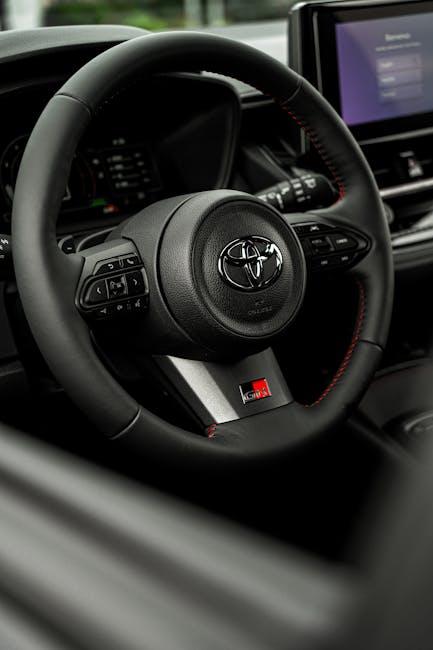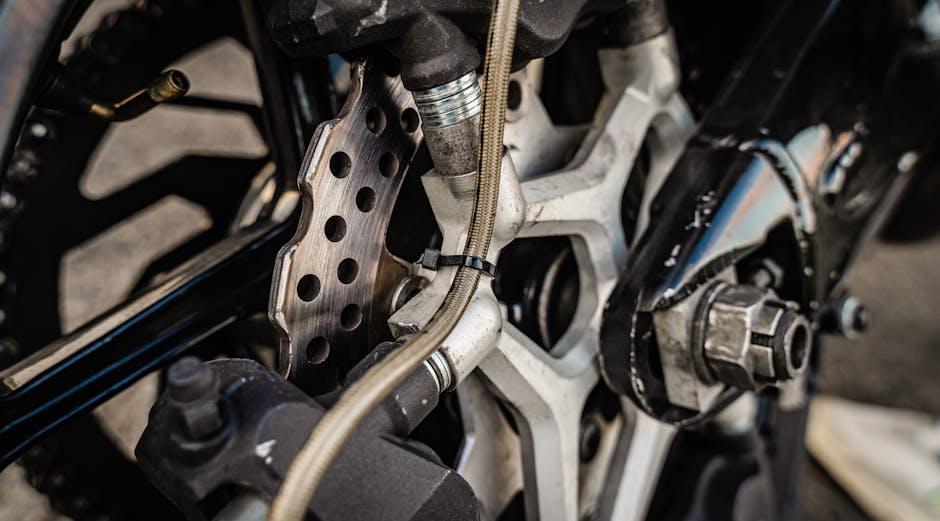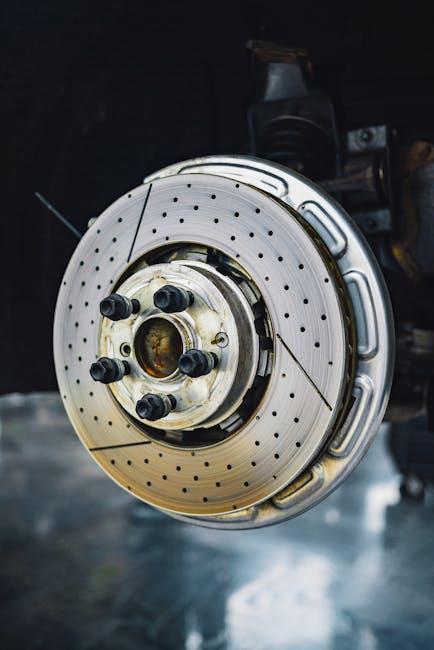Imagine sliding behind the wheel, only to feel an unsettling vibration as you press the brake pedal—a subtle warning from your car that something might be off. Warped brake rotors, though often overlooked, can turn a routine stop into a shaky experience, compromising both comfort and safety. In this article, we’ll guide you through the key signs and simple tests to determine if your rotors have lost their smoothness, helping you take control before a minor issue turns into a costly repair. Whether you’re a seasoned driver or new to vehicle maintenance, understanding how to spot warped rotors is essential for keeping your braking system in top shape.
Table of Contents
- Signs Your Steering Wheel Is Sending Warning Signals
- Feeling the Pulse: Recognizing Brake Pedal Vibrations
- The Sound of Trouble: Identifying Unusual Brake Noises
- Visual Clues: Inspecting Your Rotors for Warping
- When to Consult a Professional Mechanic for Rotor Issues
- Preventative Care Tips to Keep Your Rotors Smooth and Safe
- Q&A
- To Wrap It Up

Signs Your Steering Wheel Is Sending Warning Signals
Your steering wheel can be an early indicator of underlying brake problems, especially when it starts behaving oddly. One of the most common signs that your rotors might be warped is a noticeable vibration or shaking sensation through the steering wheel when you apply the brakes. This shaking is usually more pronounced at higher speeds and often disappears when you ease off the brake pedal. Keep in mind that the intensity and frequency of these vibrations can vary, but if you consistently feel this unsettling shake, it’s a strong hint to have your brake components inspected.
Another warning signal is if your steering wheel feels stiff or less responsive during turns after braking. This stiffness could signal uneven rotor wear or a rotor surface that isn’t flat, affecting your vehicle’s ability to maintain smooth steering motions. Additionally, pay attention to any strange noises or grinding sounds when braking—it’s not just annoying; it can be your rotors crying for help. Here’s a quick overview of typical steering wheel symptoms related to warped rotors:
- Vibration or shaking during braking
- Steering stiffness or reduced responsiveness
- Uneven pedal pressure or pulsation
- Grinding or squealing noises

Feeling the Pulse: Recognizing Brake Pedal Vibrations
When you press the brake pedal and feel an unusual pulsing or shuddering sensation, this is a key indicator that something might be off with your rotors. Unlike typical brake wear that simply results in reduced stopping power, this vibration is your car’s way of signaling that the rotors could be uneven or warped. It’s important to pay close attention to this tactile feedback, as ignoring it could lead to increased wear on your brake system and compromised safety on the road.
Here are some common characteristics of brake pedal vibrations that suggest rotor issues:
- Pulsation intensity: Often rhythmic and increases with brake pressure.
- Speed correlation: Vibration typically becomes noticeable above certain vehicle speeds, usually 30-40 mph.
- Brake activation: Only occurs when applying the brakes, disappearing once released.
- Location of feedback: Usually felt through the brake pedal but can sometimes transmit through the steering wheel.
| Vibration Symptom | Likely Cause | Suggested Action |
|---|---|---|
| Light pulsation at low speeds | Mild rotor warping or uneven wear | Resurface or replace rotors |
| Strong shaking at high speeds | Severe rotor distortion | Immediate rotor replacement recommended |
| Intermittent vibration | Brake pad issues or debris | Brake inspection and cleaning |

The Sound of Trouble: Identifying Unusual Brake Noises
When your brakes start making strange sounds, your ears might be trying to tell you more than just a simple squeak. Unusual brake noises often hint at underlying rotor problems, especially warping. Instead of the smooth, quiet stop you expect, you might hear a repetitive thumping, grinding, or a sharp chirping sound while braking. These auditory signals usually occur because the brake pads aren’t making consistent contact with the rotor’s surface due to uneven wear or heat damage, causing vibrations that translate into sound. Paying attention to these specific noises can be your first clue in diagnosing a rotor issue before it escalates into a costlier repair.
To help you distinguish between normal brake sounds and warning signs, here’s a quick guide:
- Thumping or pulsating noise: Indicates rotor warping or uneven rotor thickness.
- High-pitched squealing: Often caused by worn brake pads but can also accompany rotor problems.
- Grinding or scraping: Suggests severe rotor damage or metal-on-metal contact.
- Chirping or clicking: May mean rotor grooves or debris caught between pad and rotor.
| Noise Type | Likely Cause | Action Recommended |
|---|---|---|
| Thumping | Warped Rotors | Check rotor thickness and balance |
| Squealing | Worn Pads or Rotor Issues | Inspect pads and rotor surface |
| Grinding | Severe Rotor Damage | Immediate rotor replacement |
| Chirping | Debris or Grooves | Clean or resurface rotors |

Visual Clues: Inspecting Your Rotors for Warping
One of the most telling signs of rotor warping lies in the subtle visual imperfections your eyes can catch before any grinding noises appear. When you take a close look at the rotor surface, watch for uneven wear patterns, such as ridges, grooves, or blotchy discoloration. Warped rotors often display a distinct “wavy” texture along the edge, which can easily be mistaken for just dirt or rust if you’re not looking closely. A quick tip: shining a flashlight at an angle across the rotor can help highlight these irregularities by casting shadows along the warped edges.
Another clever way to spot trouble is by examining the rotor after a braking event. If you notice a series of heat spots or blue discolorations on the rotor surface, this is an indicator of excessive friction, often caused by uneven rotor thickness from warping. Even slight bulges or dips can disrupt the smooth contact between brake pads and rotors, so don’t overlook these visual cues:
- Warped rotors often feel more textured than smooth when you run your fingers across
- Edges of the rotor might show unusual wear compared to the center span
- Look for visible cracks, especially near mounting holes, which can accompany warping
| Visual Sign | Possible Cause | Severity |
|---|---|---|
| Wavy edges | Heat expansion and cooling cycles | Moderate to high |
| Blue heat spots | Overheating from repeated braking | High |
| Grooves & ridges | Uneven pad contact | Low to moderate |

When to Consult a Professional Mechanic for Rotor Issues
When signs point to rotor issues, especially persistent vibrations or uneven brake pads wear, it’s wise to reach out to a professional mechanic. A trained expert can accurately diagnose whether rotor warping is the cause, or if other brake components need attention. Attempting DIY fixes without proper tools and expertise can lead to further damage or compromised safety, so knowing when to pause and seek help is crucial for maintaining your vehicle’s braking performance.
Several subtle symptoms might mean it’s time for a professional inspection:
- Frequent pulsating in the brake pedal despite resurfacing or pad replacement
- Uneven brake pad thickness causing inconsistent braking force
- Unusual noises like grinding or squealing during braking
- Visual rotor damage such as scoring, cracking, or deep grooves
Additionally, regular maintenance intervals provide excellent opportunities for a mechanic to check rotor health before severe problems develop.

Preventative Care Tips to Keep Your Rotors Smooth and Safe
Maintaining smooth and safe rotors is all about consistent attention and timely service. Regular inspections can catch early signs of rotor wear before they escalate into costly repairs. Make it a habit to check for uneven wear patterns or scoring marks every 5,000 miles, especially if you frequently drive in hilly or stop-and-go traffic. Additionally, always allow your brakes to cool down after heavy use to prevent heat buildup, which is one of the main culprits behind warped rotors.
Incorporating simple habits can dramatically extend your rotor’s lifespan:
- Use quality brake pads: Inferior pads can create excessive dust and heat, damaging rotors more quickly.
- Avoid harsh braking: Smooth, gradual stops reduce stress on your braking components.
- Keep your suspension in check: Misaligned wheels can cause uneven rotor wear.
| Maintenance Step | Frequency | Impact on Rotors |
|---|---|---|
| Visual Inspection | Every 5,000 miles | Detects early warping signs |
| Brake Pad Replacement | Every 30,000-50,000 miles | Prevents rotor damage and scoring |
| Suspension Check | Annually | Ensures even pressure distribution |
Q&A
Q&A: How to Tell if Your Rotors Are Warped
Q: What exactly are brake rotors, and why do they matter?
A: Brake rotors are metal discs attached to your wheels that work with brake pads to slow or stop your car. When you press the brake pedal, the pads clamp down on the rotors, creating friction. Healthy rotors are crucial for smooth, safe braking.
Q: What does it mean for rotors to be “warped”?
A: Warped rotors aren’t perfectly flat anymore—they’ve become uneven or distorted, often due to excessive heat buildup or wear. This distortion can cause vibrations or pulsations when braking.
Q: How can I tell if my rotors are warped?
A: The classic sign is a vibration or shaking sensation in the brake pedal or steering wheel when you brake. You might also notice unusual noises like a pulsating thump or squealing. Sometimes, visually inspecting the rotor surface reveals grooves or discoloration, hinting at damage.
Q: Can I feel warped rotors while driving normally, or only when braking?
A: Warped rotors generally make themselves known only during braking. While cruising at speed, your drive will usually feel smooth, but press the brake pedal, and vibrations can appear.
Q: Are there any subtle symptoms I should watch for?
A: Yes, uneven brake pad wear, longer stopping distances, or a “soft” or inconsistent brake pedal feel can point toward rotor problems. If your car pulls slightly to one side when braking, warped rotors could be a culprit.
Q: Could something else cause similar symptoms?
A: Absolutely. Issues like worn brake pads, damaged wheel bearings, or suspension problems can mimic warped rotor symptoms. That’s why a professional inspection is often the safest bet.
Q: Can I fix warped rotors, or do I need to replace them?
A: Minor warping sometimes can be corrected by resurfacing—machining the rotor to restore a smooth, flat surface. But if the warping is severe or the rotors are too thin, replacement is the better option.
Q: How can I prevent rotors from warping in the first place?
A: Avoid excessive or sudden braking, especially on steep declines. Give your brakes time to cool after heavy use, and keep up with regular maintenance. Quality brake pads and proper installation make a big difference, too.
Q: Is it dangerous to drive with warped rotors?
A: Warped rotors can compromise your braking smoothness and efficiency, which might increase stopping distances and reduce safety. It’s best to address the issue promptly to keep your vehicle running safely.
Q: When should I see a mechanic about warped rotors?
A: If you feel shaking, hear unusual noises during braking, or notice any decrease in brake performance, schedule a checkup soon. Catching rotor issues early saves money and stress down the road.
To Wrap It Up
In the end, understanding whether your rotors are warped is a key step in ensuring both your safety and the longevity of your vehicle. By staying attentive to the subtle signs—those vibrations, noises, or uneven wear—you can catch potential problems before they escalate. Remember, a smooth ride isn’t just about comfort; it’s a signal that your brakes are functioning as they should. So, keep an eye, listen closely, and when in doubt, don’t hesitate to seek professional advice. After all, peace of mind on the road is worth every bit of care.
